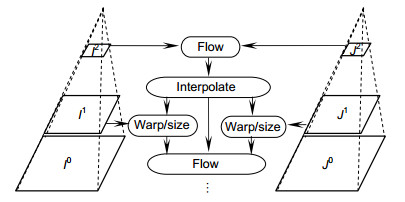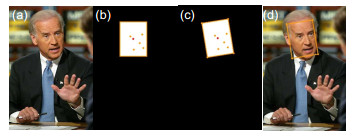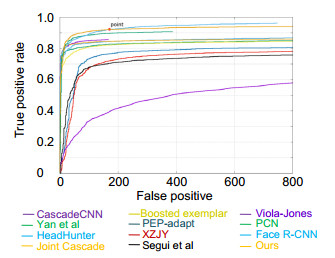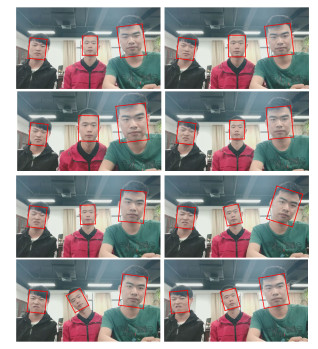Rotating invariant face detection via cascaded networks and pyramidal optical flows
-
摘要:
在无约束的开放空间中,由于面部姿态变化、背景环境复杂、运动模糊等,人脸检测仍是一个具有挑战性的任务。本文针对视频流中人脸检测存在的平面内旋转问题,将人脸关键点与金字塔光流相结合,提出了基于级联网络和金字塔光流的旋转不变人脸检测算法。首先利用级联渐进卷积神经网络对视频流中前一帧进行人脸位置和关键点的定位;其次为获取关键点与人脸候选框间光流映射,使用独立的关键点检测网络对当前帧进行再次定位;之后计算前后两帧之间关键点光流位移;最后通过关键点光流位移与人脸候选框的映射关系,对视频中检测到的人脸进行校正,从而完成平面内旋转人脸不变性检测。实验经FDDB公开数据集上测试,证明该方法精确度较高。并且,在Boston面部跟踪数据集上进行动态测试,证明该人脸检测算法能有效解决平面内旋转人脸检测问题。对比其它检测算法,该算法检测速度有较大优势,同时视频中窗口抖动问题得到了很好解决。
 Abstract:
Abstract:In the unconstrained open-space, face detection is still a challenging task due to the facial posture changes, complex background environment, and motion blur. The rotation-invariant algorithm based on cascaded network and pyramid optical flow is proposed. Firstly, the cascading progressive convolutional neural network is adopted to locate the face position and facial landmark of the previous frame in the video stream. Secondly, the independent facial landmark detection network is used to reposition the current frame, and the optical flow mapping displacement of the facial landmark between the two frames is calculated afterwards. Finally, the detected face is corrected by the mapping relationship between the optical flow displacement of the facial landmark and the bounding box, thereby completing the rotation-invariant face detection. The experiment was tested on the FDDB public datasets, which proved that the method is more accurate. Moreover, the dynamic test on the Boston head tracking database proves that the face detection algorithm can effectively solve the problem of rotation-invariant face detection. Compared with other detection algorithms, the detection speed of the proposed algorithm has a great advantage, and the window jitter problem in the video is well solved.
-
Key words:
- rotation-invariant /
- facial landmark /
- calibration networks /
- pyramid optical flow /
- face detection
-

Overview: In recent years, with the rapid deployment of video surveillance in urban space, the public security department has collected video in a massive unconstrained open environment. There are complex problems such as scale change, partial occlusion, motion blur and illumination change in the face detection of video stream. In particular, face rotation affects the performance and efficiency of the entire face recognition system. In this paper, the in-plane rotation problem of face detection in video stream is combined with the pyramid optical flow, and a rotating invariant face detection algorithm based on cascaded network and pyramid optical flow is proposed. Firstly, the cascading progressive convolutional neural network is used to locate the face position and facial landmark of the previous frame in the video stream. Secondly, the optical flow mapping between the facial landmark and the bounding box is obtained, and the independent facial landmark network is used to detect the current frame. After that, the optical flow displacement of the key points between the two frames is calculated. Finally, the detected face of the video is corrected by the mapping relationship between the optical flow displacement of the key point and the face candidate frame, thereby completing the rotation-invariant face detection. The experiments were tested on the FDDB public datasets. The ROC curve on the FDDB evaluates the performance of the face detection method. When the number of false positives is less than 160, the performance of our method is better than other methods. When the number of false positives is more than 160, the face detection result is close to Face R-CNN, which proves that the method has higher accuracy. Moreover, the dynamic test on the Boston head tracking database proves that the face detection algorithm can effectively solve the problem of rotation and scale change of the target area in the plane. The speed of this algorithm with other rotationally invariant face detectors on standard.mp4 video is compared. The minimum face size of these images is 100×100. The experimental video has a uniform length of 10 s, a frame rate of 30 frames/s, and a picture size of 640×480. Experiments show that the algorithm detection speed has a great advantage, and the window jitter problem in the video is well solved. The average detection rate of the algorithm in this paper is higher than the general video frame rate, and the model size is small, which is suitable for mobile devices. Time costs are greatly reduced compared to the methods of learning rotational invariant features and segmenting samples by highly complex networks.
-

-
表 1 视频流中人脸检测算法效率及相应模型大小
Table 1. Speed and model size between different methods
Method CPU/fps GPU/fps Model size/M Faster R-CNN(VGGM) 1 21 350 Faster R-CNN(VGG16) 0.5 11 547 Cascade CNN 31 68 4.2 Cascade CNN+STN 15 31 4.7 Divide-and-Conquer 14 21 2.2 SSD500 1 21 95 R-FCN(ResNet-50) 0.8 16 123 Our 34 64 3.7 -
[1] Viola P, Jones M. Rapid object detection using a boosted cascade of simple features[C]//Proceedings of the 2001 IEEE Computer Society Conference on Computer Vision and Pattern Recognition, 2001.
[2] Li B, Yang A M, Yang J. Rotated face detection using AdaBoost[C]//Proceedings of 2010 2nd International Conference on Information Engineering and Computer Science, 2010: 1-4.
[3] Froba B, Ernst A. Face detection with the modified census transform[C]//Proceedings of the Sixth IEEE International Conference on Automatic Face and Gesture Recognition, 2004: 91-96.
[4] Jin H L, Liu Q S, Lu H Q, et al. Face detection using improved LBP under Bayesian framework[C]//Proceedings of the Third International Conference on Image and Graphics, 2004: 306-309.
[5] Farfade S S, Saberian M J, Li L J. Multi-view face detection using deep convolutional neural networks[C]//Proceedings of the 5th ACM on International Conference on Multimedia Retrieval, 2015: 643-650.
[6] Ranjan R, Patel V M, Chellappa R. A deep pyramid deformable part model for face detection[C]//Proceedings of 2015 IEEE 7th International Conference on Biometrics Theory, Applications and Systems, 2015.
[7] Yang S, Luo P, Loy C C, et al. From facial parts responses to face detection: a deep learning approach[C]//Proceedings of 2015 IEEE International Conference on Computer Vision, 2015.
[8] Bas A, Huber P, Smith W A P, et al. 3D morphable models as spatial transformer networks[C]//Proceedings of 2017 IEEE International Conference on Computer Vision Workshops, 2017.
[9] 李小薪, 梁荣华.有遮挡人脸识别综述:从子空间回归到深度学习[J].计算机学报, 2018, 41(1): 177-207. http://d.old.wanfangdata.com.cn/Periodical/jsjxb201801011
Li X X, Liang R H. A review for face recognition with occlusion: from subspace regression to deep learning[J]. Chinese Journal of Computers, 2018, 41(1): 177-207. http://d.old.wanfangdata.com.cn/Periodical/jsjxb201801011
[10] Ren S Q, He K M, Girshick R, et al. Faster R-CNN: towards real-time object detection with region proposal networks[C]//Proceedings of the 28th International Conference on Neural Information Processing Systems, 2015: 91-99.
[11] Liu W, Anguelov D, Erhan D, et al. Single shot MultiBox detector[C]//Proceedings of the 14th European Conference on Compute Vision (ECCV), 2016: 21-37.
[12] Redmon J, Divvala S, Girshick R, et al. You only look once: unified, real-time object detection[C]//Proceedings of 2016 IEEE Conference on Computer Vision and Pattern Recognition, 2016.
[13] Simonyan K, Zisserman A. Very deep convolutional networks for large-scale image recognition[C]//Proceedings of the 3rd International Conference on Learning Representations, 2015.
[14] Li H X, Lin Z, Shen X H, et al. A convolutional neural network cascade for face detection[C]//Proceedings of 2015 IEEE Conference on Computer Vision and Pattern Recognition, 2015: 5325-5334.
[15] 潘榕, 魏慧琴.基于旋转不变性的人脸定位识别研究[J].计算机工程与设计, 2009, 30(8): 1941-1943, 1997. http://d.old.wanfangdata.com.cn/Periodical/jsjgcysj200908035
Pan R, Wei H Q. Research on human face detection and recognition based on rotation invariance[J]. Computer Engineering and Design, 2009, 30(8): 1941-1943, 1997. http://d.old.wanfangdata.com.cn/Periodical/jsjgcysj200908035
[16] 王炜强, 张晓阳, 曹春芹, 等.尺度不变单样本人脸识别方法[J].中国图象图形学报, 2012, 17(3): 380-386. http://d.old.wanfangdata.com.cn/Periodical/zgtxtxxb-a201203012
Wang W Q, Zhang X Y, Gao C Q, et al. Scale invariant face recognition from single sample[J]. Journal of Image and Graphics, 2012, 17(3): 380-386. http://d.old.wanfangdata.com.cn/Periodical/zgtxtxxb-a201203012
[17] 包晓安, 胡玲玲, 张娜, 等.基于级联网络的快速人脸检测算法[J].浙江理工大学学报, 2019, 41(3): 347-353. doi: 10.3969/j.issn.1673-3851(n).2019.03.011
Bao X A, Hu L L, Zhang N, et al. Fast face detection algorithm based on cascade network[J]. Journal of Zhejiang Sci-Tech University, 2019, 41(3): 347-353. doi: 10.3969/j.issn.1673-3851(n).2019.03.011
[18] 刘伟强.基于级联卷积神经网络的人脸检测算法的研究[D].厦门: 厦门大学, 2017.
Liu W Q. Research on face detection algorithm based on cascaded convolutional neural networks[D]. Xiamen: Xiamen University, 2017.
http://cdmd.cnki.com.cn/Article/CDMD-10384-1017120170.htm [19] 孙康, 李千目, 李德强.基于级联卷积神经网络的人脸检测算法[J].南京理工大学学报, 2018, 42(1): 40-47. http://d.old.wanfangdata.com.cn/Periodical/njlgdxxb201801006
Sun K, Li Q M, Li D Q. Face detection algorithm based on cascaded convolutional neural network[J]. Journal of Nanjing University of Science and Technology, 2018, 42(1): 40-47. http://d.old.wanfangdata.com.cn/Periodical/njlgdxxb201801006
[20] 林露樾.融合卷积神经网络以及光流法的目标跟踪方法[D].广州: 广东工业大学, 2018.
Lin L Y. A visual object tracking method via CNN and optical flow with online learning[D]. Guangzhou: Guangdong University of Technology, 2018.
[21] 王正来, 黄敏, 朱启兵, 等.基于深度卷积神经网络的运动目标光流检测方法[J].光电工程, 2018, 45(8): 38-47. doi: 10.12086/oee.2018.180027
Wang Z L, Huang M, Zhu Q B, et al. The optical flow detection method of moving target using deep convolution neural network[J]. Opto-Electronic Engineering, 2018, 45(8): 38-47. doi: 10.12086/oee.2018.180027
[22] Zhang K P, Zhang Z P, Li Z F, et al. Joint face detection and alignment using multitask cascaded convolutional networks[J]. IEEE Signal Processing Letters, 2016, 23(10): 1499-1503. doi: 10.1109/LSP.2016.2603342
[23] Yang S, Luo P, Loy C C, et al. WIDER FACE: a face detection benchmark[C]//Proceedings of 2016 IEEE Conference on Computer Vision and Pattern Recognition, 2016.
[24] Liu Z W, Luo P, Wang X G, et al. Deep learning face attributes in the wild[C]//Proceedings of 2015 IEEE International Conference on Computer Vision, 2015: 3730-3738.
[25] Sun Y, Wang X G, Tang X O. Deep convolutional network cascade for facial point detection[C]//Proceedings of 2013 IEEE Conference on Computer Vision and Pattern Recognition, 2013: 3476-3483.
[26] Köstinger M, Wohlhart P, Roth P M, et al. Annotated facial landmarks in the wild: a large-scale, real-world database for facial landmark localization[C]//Proceedings of 2011 IEEE International Conference on Computer Vision Workshops, 2011: 2144-2151.
[27] Jain V, Learned-Miller E G. FDDB: A benchmark for face detection in unconstrained settings[R]. UMass Amherst Technical Report, 2010.
[28] Cascia M L, Sclaroff S. Fast, reliable head tracking under varying illumination[C]// Proceedings of 1999 IEEE Computer Society Conference on Computer Vision and Pattern Recognition, 1999: 604-610.
[29] Wang H, Li Z F, Ji X, et al. Face R-CNN[C]//2017 IEEE Conference on Computer Vision and Pattern Recognition, 2017.
-


 E-mail Alert
E-mail Alert RSS
RSS

 下载:
下载:











